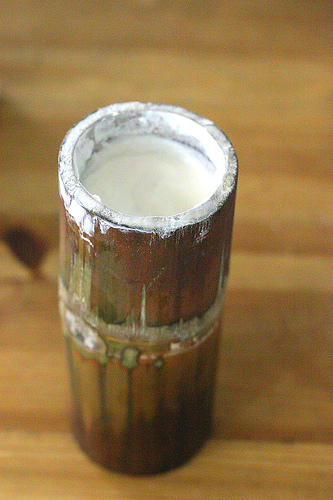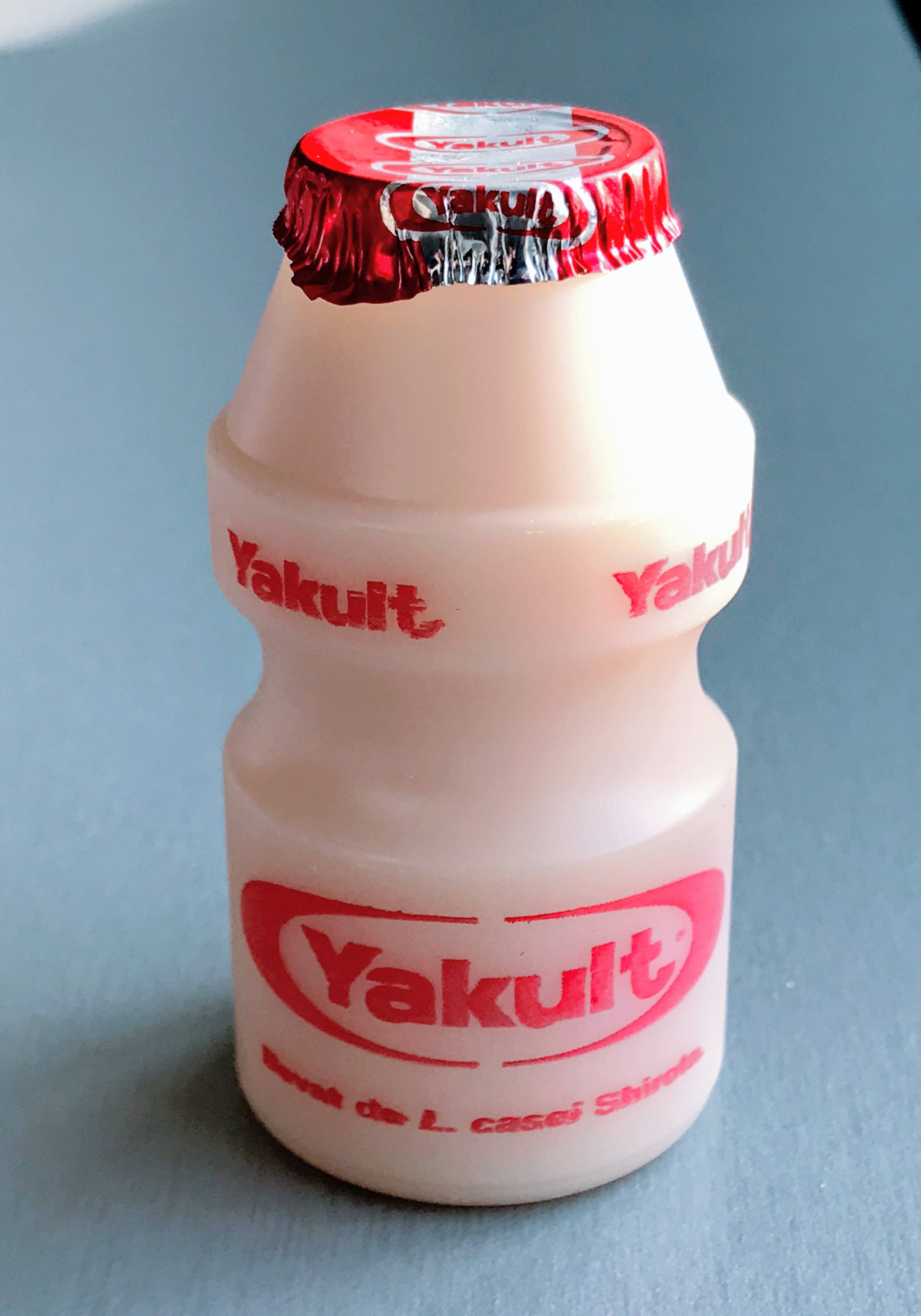|
Filmjölk
(), also known as , is a traditional fermented milk product from Sweden, and a common dairy product within the Nordic countries. It is made by fermenting cow's milk with a variety of bacteria from the species ''Lactococcus lactis'' and ''Leuconostoc mesenteroides''. The bacteria metabolize lactose, the sugar naturally found in milk, into lactic acid, which means people who are lactose intolerant can tolerate it better than other dairy products. The acid gives a sour taste and causes proteins in the milk, mainly casein, to coagulate, thus thickening the final product. The bacteria also produce a limited amount of diacetyl, a compound with a buttery flavor, which gives its characteristic taste. has a mild and slightly acidic taste. It has a shelf-life of around 10–14 days at refrigeration temperature. Overview In the Nordic countries, is often eaten with breakfast cereal, muesli or crushed crisp bread on top. Some people add sugar, jam, apple sauce, cinnamon, ging ... [...More Info...] [...Related Items...] OR: [Wikipedia] [Google] [Baidu] |
Fermented Milk Product
Fermented milk products or fermented dairy products, also known as cultured dairy foods, cultured dairy products, or cultured milk products, are dairy foods that have been fermented with lactic acid bacteria such as ''Lactobacillus'', '' Lactococcus'', and ''Leuconostoc''. The fermentation process increases the shelf life of the product while enhancing its taste and improving the digestibility of its milk. There is evidence that fermented milk products have been produced since around 10,000 BC. A range of different Lactobacilli strains has been grown in laboratories allowing for many cultured milk products with different flavors and characteristics. Products Many different types of cultured milk products can be found around the world including milk, cheese, yogurt, other cultured dairy foods, ice cream and more. Soured milk Soured cream Comparison chart * '' Streptococcus lactis'' has been renamed to ''Lactococcus lactis'' subsp. ''lactis'' See also * List of d ... [...More Info...] [...Related Items...] OR: [Wikipedia] [Google] [Baidu] |
Kefir
Kefir ( ; also spelled as kephir or kefier; ; ; ) is a fermented milk drink similar to a thin yogurt or ayran that is made from kefir grains, a specific type of mesophilic symbiotic culture. The drink originated in the North Caucasus, in particular the Elbrus region along the upper mountainous sections of Circassia, Karachay and Balkaria, from where it came to Russia, and from there it spread to Europe and the United States, where it is prepared by inoculating the milk of cows, goats, or sheep with kefir grains. Kefir is a breakfast, lunch, and dinner drink popular across Russia, Belarus, Estonia, Hungary, Latvia, Lithuania, Poland, Romania, and Ukraine - where it is known as an affordable health drink. It is also known in Norway, Sweden, and Finland, where buttermilk-type fermented dairy drinks are common. Kefir is common particularly among Russian and Estonian minorities. In South Slavic countries, kefir is consumed at any time of the day, especially with zelnik/zel ... [...More Info...] [...Related Items...] OR: [Wikipedia] [Google] [Baidu] |
Bifidobacterium Animalis
''Bifidobacterium animalis'' is a gram-positive, anaerobic, rod-shaped bacterium of the ''Bifidobacterium'' genus which can be found in the large intestines of most mammals, including humans. ''Bifidobacterium animalis'' and ''Bifidobacterium lactis'' were previously described as two distinct species. Presently, both are considered ''B. animalis'' with the subspecies ''Bifidobacterium animalis'' subsp. ''animalis'' and ''Bifidobacterium animalis'' subsp. ''lactis''. Both old names ''B. animalis'' and ''B. lactis'' are still used on product labels, as this species is frequently used as a probiotic. In most cases, which subspecies is used in the product is not clear. Trade names Several companies have attempted to trademark particular strains, and as a marketing technique, have invented scientific-sounding names for the strains. Danone (Dannon in the United States) markets the subspecies strain as Bifidus Digestivum (UK), Bifidus Regularis (US and Mexico), Bifidobacterium Lact ... [...More Info...] [...Related Items...] OR: [Wikipedia] [Google] [Baidu] |
Probiotic
Probiotics are live microorganisms promoted with claims that they provide health benefits when consumed, generally by improving or restoring the gut microbiota. Probiotics are considered generally safe to consume, but may cause bacteria- host interactions and unwanted side effects in rare cases. There is some evidence that probiotics are beneficial for some conditions, but there is little evidence for many of the health benefits claimed for them. The first discovered probiotic was a certain strain of bacillus in Bulgarian yoghurt, called ''Lactobacillus bulgaricus''. The discovery was made in 1905 by Bulgarian physician and microbiologist Stamen Grigorov. The modern-day theory is generally attributed to Russian Nobel laureate Élie Metchnikoff, who postulated around 1907 that yoghurt-consuming Bulgarian peasants lived longer. A growing probiotics market has led to the need for stricter requirements for scientific substantiation of putative benefits conferred by microorgan ... [...More Info...] [...Related Items...] OR: [Wikipedia] [Google] [Baidu] |
Arla Foods
, industry = Dairy , predecessor = ArlaMD Foods , founded = , founder = , location_city = Viby , location_country = Denmark , area_served = Worldwide , key_people = Peder Tuborgh (CEO)Jan Toft Nørgaard (Chairman)Jonathan Evans ( UK milk) , products = , revenue = 10.3 billion EUR (2017) , operating_income = 505 million EUR (2016) , net_income = 356 million EUR (2016) , num_employees = 18,765 (2016) , parent = , subsid = Arla Foods FinlandArla Foods UK , website = Arla Foods amba is a Danish- Swedish multinational cooperative based in Viby, Denmark, and the largest producer of dairy products in Scandinavia, and the largest dairy in the United Kingdom. Arla Foods was formed as the result of a merger between the Swedish dairy cooperative Arla and the Danish dairy company MD Foods on 17 April 2000. The name Arla derives from the ... [...More Info...] [...Related Items...] OR: [Wikipedia] [Google] [Baidu] |
Standardised
Standardization or standardisation is the process of implementing and developing technical standards based on the consensus of different parties that include firms, users, interest groups, standards organizations and governments. Standardization can help maximize compatibility, interoperability, safety, repeatability, or quality. It can also facilitate a normalization of formerly custom processes. In social sciences, including economics, the idea of ''standardization'' is close to the solution for a coordination problem, a situation in which all parties can realize mutual gains, but only by making mutually consistent decisions. History Early examples Standard weights and measures were developed by the Indus Valley civilization.Iwata, Shigeo (2008), "Weights and Measures in the Indus Valley", ''Encyclopaedia of the History of Science, Technology, and Medicine in Non-Western Cultures (2nd edition)'' edited by Helaine Selin, pp. 2254–2255, Springer, . The centralized w ... [...More Info...] [...Related Items...] OR: [Wikipedia] [Google] [Baidu] |
Homogenization (chemistry)
Homogenization or homogenisation is any of several processes used to make a mixture of two mutually non-soluble liquids the same throughout. This is achieved by turning one of the liquids into a state consisting of extremely small particles distributed uniformly throughout the other liquid. A typical example is the homogenization of milk, wherein the milk fat globules are reduced in size and dispersed uniformly through the rest of the milk. Definition Homogenization (from "homogeneous;" Greek, ''homogenes'': ''homos,'' same + ''genos,'' kind) is the process of converting two immiscible liquids (i.e. liquids that are not soluble, in all proportions, one in another) into an emulsion (Mixture of two or more liquids that are generally immiscible). Sometimes two types of homogenization are distinguished: primary homogenization, when the emulsion is created directly from separate liquids; and secondary homogenization, when the emulsion is created by the reduction in size of droplets ... [...More Info...] [...Related Items...] OR: [Wikipedia] [Google] [Baidu] |
Pasteurised
Pasteurization American and British English spelling differences#-ise, -ize (-isation, -ization), or pasteurisation is a process of food preservation in which packaged and non-packaged foods (such as milk and fruit juices) are treated with mild heat, usually to less than , to eliminate pathogens and extend shelf life. The process is intended to destroy or deactivate microorganisms and enzymes that contribute to food spoilage or risk of disease, including vegetative bacteria, but most Endospore, bacterial spores survive the process. The process is named after the French microbiologist Louis Pasteur whose research in the 1860s demonstrated that thermal processing would deactivate unwanted microorganisms in wine. Spoilage enzymes are also inactivated during pasteurization. Today, pasteurization is used widely in the dairy industry and other food processing industries to achieve food preservation and food safety. By the year 1999, most liquid products were heat treated in a cont ... [...More Info...] [...Related Items...] OR: [Wikipedia] [Google] [Baidu] |
Lithuania
Lithuania (; lt, Lietuva ), officially the Republic of Lithuania ( lt, Lietuvos Respublika, links=no ), is a country in the Baltic region of Europe. It is one of three Baltic states and lies on the eastern shore of the Baltic Sea. Lithuania shares land borders with Latvia to the north, Belarus to the east and south, Poland to the south, and Russia to the southwest. It has a Maritime boundary, maritime border with Sweden to the west on the Baltic Sea. Lithuania covers an area of , with a population of 2.8 million. Its capital and largest city is Vilnius; other major cities are Kaunas and Klaipėda. Lithuanians belong to the ethno-linguistic group of the Balts and speak Lithuanian language, Lithuanian, one of only a few living Baltic languages. For millennia the southeastern shores of the Baltic Sea were inhabited by various Balts, Baltic tribes. In the 1230s, Lithuanian lands were united by Mindaugas, Monarchy of Lithuania, becoming king and founding the Kingdom of Lithuania ... [...More Info...] [...Related Items...] OR: [Wikipedia] [Google] [Baidu] |
Latvian Cuisine
Latvian cuisine typically consists of agricultural products, with meat featuring in most main meal dishes. Fish is commonly consumed due to Latvia's location on the eastern shore of the Baltic Sea. Latvian cuisine has been influenced by other countries of the Baltic rim."Latvian Cuisine." Accessed September 2011. |
Berry
A berry is a small, pulpy, and often edible fruit. Typically, berries are juicy, rounded, brightly colored, sweet, sour or tart, and do not have a stone or pit, although many pips or seeds may be present. Common examples are strawberries, raspberries, blueberries, blackberries, red currants, white currants and blackcurrants. In Britain, soft fruit is a horticultural term for such fruits. In common usage, the term "berry" differs from the scientific or botanical definition of a fruit produced from the ovary of a single flower in which the outer layer of the ovary wall develops into an edible fleshy portion ( pericarp). The botanical definition includes many fruits that are not commonly known or referred to as berries, such as grapes, tomatoes, cucumbers, eggplants, bananas, and chili peppers. Fruits commonly considered berries but excluded by the botanical definition include strawberries, raspberries, and blackberries, which are aggregate fruits and mulberries, which ar ... [...More Info...] [...Related Items...] OR: [Wikipedia] [Google] [Baidu] |





